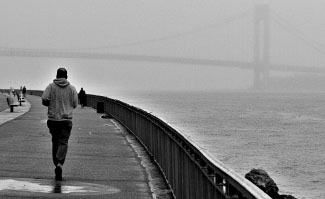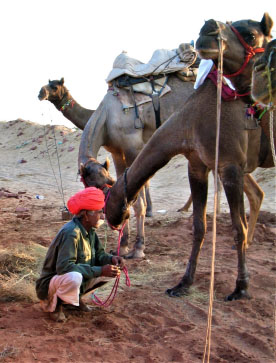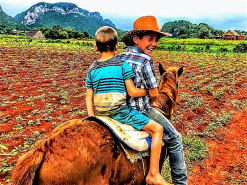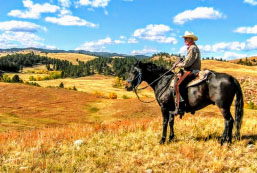Shoot Photos Like A Pro
(Or Close To It)
By Bob Kappstatter
Okay, so your vacation photos won’t (necessarily) show up in National Geographic or Travel + Leisure, but that doesn’t mean you can’t improve those “smile for the camera” and “sunset over the beach” shots. And maybe even get some real “oohs” and “aahs” for your pix.
 This photo combines examples of The Rule of Thirds, leading lines, level horizons, shooting on a misty day—and the impact of black-and-white photography.
This photo combines examples of The Rule of Thirds, leading lines, level horizons, shooting on a misty day—and the impact of black-and-white photography.I have been a semi-professional photographer for decades, doing travel pieces around the globe while a full-time newsman at the NY Daily News, as well as pursuing my passion for street and personal photography.
Whether capturing the sights of New York City, Cuba, Africa, India, Europe, or the photographic wonders of America, it has involved years of studying, learning from my mistakes, or just plain lucky moments. Perhaps this is your journey too. So, let’s help it along with some basics.
SEEING THE PHOTO
It sounds simple but seeing a potential photo takes practice, calls for awareness. That’s why I love being in a new place. Your senses come alive. The trick is to isolate and frame what strikes your eye while eliminating distractions from the photo.
 The “Golden Light” of an early morning sun helped create this dramatic shot in the Indian desert.
The “Golden Light” of an early morning sun helped create this dramatic shot in the Indian desert.COMPOSITION
We can’t cover it all here. Please do hit the Internet and YouTube for further study. Meanwhile, here are some of our essential tips:
• Framing The Rule of Thirds is fundamental in framing a photo. Look for or imagine a crosshatch in your viewer. Your main subject should be lined up along one of those lines or where they intersect. Leaving two-thirds of generally secondary space in the photo, be it a wall or whatever, gives the subject dramatic focus.
• Straight Lines Also, use those crosshatch lines to make sure those horizons in your sunset shots, wall, window, and door frames are vertically and horizontally straight.
• Space It’s better to leave some room in the frame for cropping later. And do make sure to leave some space above a person’s head and below their feet.
• Symmetry If you want to center the main subject, make sure it’s dead center—another reason to leave some room for cropping.
• Angles Look up, look down, and try shooting other than dead-on for a more dramatic effect. Also, look for leading lines sweeping diagonally across the frame.
• Background Shooting someone in front of a building? If you want most of the building in the shot, bring the person forward so they’ll be a dramatic element in the foreground. The same applies to having some object in the foreground.
• Distractions Watch out for distracting elements in the photo, including shadows, as well as telephone poles and wires sticking out of a person’s head.
• Portraits Besides a dead-on look at the camera, try different angles. And keep an easy conversation going to relax them, so it’s not just one of those grimaced-looking “Say cheese!” shots.
 Background barn and foreground truck made for a great shot in Western North Carolina.
Background barn and foreground truck made for a great shot in Western North Carolina.
LIGHT
Along with subject and composition, lighting is the third most important element in a good photo. When the sun is giving what photographers call the Golden Light, early morning and late afternoon are generally the best times for dramatic looking photos. Mid-day sun is usually best for landscapes, while cloudy or misty days can make for great shadow-less, moody photos.
 This cell phone shot while visiting a Cuban tobacco farm is a great example of being prepared for the unexpected.
This cell phone shot while visiting a Cuban tobacco farm is a great example of being prepared for the unexpected.
 “A smile goes a mile” resulted in this photo of these two Brooklyn motorcycle club members.
“A smile goes a mile” resulted in this photo of these two Brooklyn motorcycle club members.
BLACK AND WHITE
One of the most significant discoveries I’ve made in photography has been converting many of my color photos to black and white. Please don’t overlook the dramatic effect it can have, especially with people shots.
 South Dakota: An example of the Rule of Thirds and filling foreground to complement scenics.
South Dakota: An example of the Rule of Thirds and filling foreground to complement scenics.
 San Francisco: Centering your subject and waiting patiently for what French master photographer Henri Cartier-Bresson called the decisive moment.
San Francisco: Centering your subject and waiting patiently for what French master photographer Henri Cartier-Bresson called the decisive moment.APPROACHING PEOPLE
One of the hardest things for most people is approaching a stranger for their photo. I generally try to shoot candid images first. But I also try to involve people directly. My Number One rule has always been “a smile goes a mile.” Whether it has been a desert camel trader in India, a Maasi warrior in Africa, or motorcycle gang members in Brooklyn, a smile and telling them they look great or interesting and that you’d love to photograph them usually works. And of course, kids are always great. Just make sure their parents are okay with it.
EQUIPMENT
You can spend all kinds of money on expensive cameras, and usually get more features and sharper photos. But most folks already use a camera that’s with them all the time—their cell phones. Today’s phones have excellent quality lenses and some great photo tools. We like the portrait setting, which brings out a sharp, quality look. Also, the continuous shots you get holding down the shutter, great for when your subject may have briefly closed their eyes, and for catching moving subjects.
MOVING UP
If you're using a regular camera, you can always keep it set on automatic mode. But why spend the money if you don't want to take advantage of all its bells and whistles for more professional-quality photos? Besides the camera's manual, take advantage of the Internet and YouTube, which have a number of excellent tutorials.
One final note. Don’t spend all your time going nuts with your camera while on vacation. Enjoy, and be sure to buy a few postcards!
Visit Bob Kappstatter on Instagram @bobkappstatter






